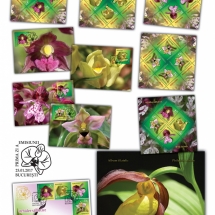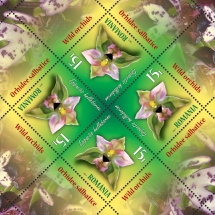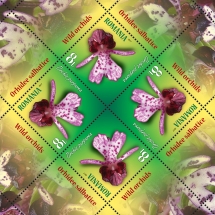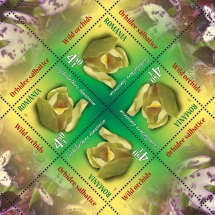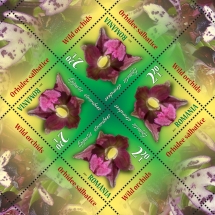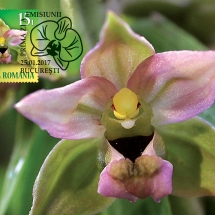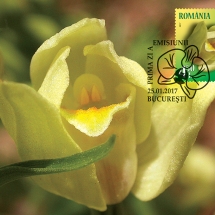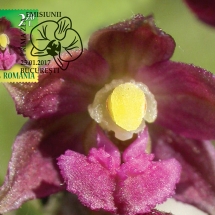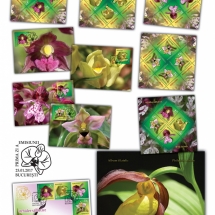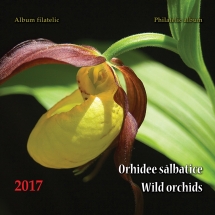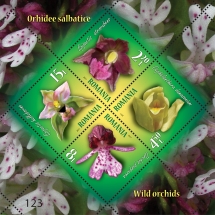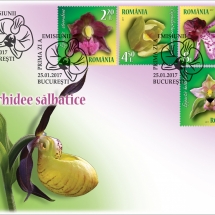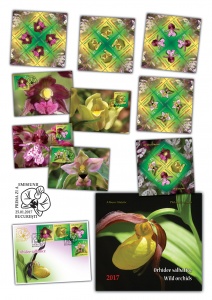
Sophisticated and delicate, in graceful shapes and beautiful colours, orchids are most often associated with distant islands and tropical paradises. Few of us know that Romania is also the realm of these gorgeous flowers, bringing together about 70 different species of wild orchids. Hosted by our country’s hills and mountains, these orchids bloom from spring to autumn, some of them being very rare, and most of them being threatened by expanding human activities.
Romfilatelia brings you some of these beauties of nature in the latest postage stamp issue suggestively entitled Wild Orchids. The four values of the issue are available starting with Wednesday, January 25th, 2017, in all Romfilatelia shops from Bucharest, Bacau, Brasov, Cluj-Napoca, Iasi and Timisoara.
Thus, the stamp with the face value of lei 2.20 illustrates Epipactis atrorubens, in its popular name Dark Red Helleborine. It is a resistant plant, with a short and hairy rootstalk, blooming from June to July, with inflorescences standing between 20 and 80 cm in height. Its flowers, usually in shades of reddish-brown, spread a strong vanilla scent, especially in warm weather. It is widespread across Europe and, fortunately, it is not one of the most severely threatened species of orchids.
Cephalanthera damasonium (the White Helleborine), found on the stamp with the face value of lei 4.50, is a species of orchid which is widespread across much of Europe and the Middle East, from England and Sweden to Russia and Iran; it is also found in Bhutan, India, Myanmar and Yunnan.
It is the type species of the genus Cephalanthera, with flowers that hardly open because they are autogamous (self-pollinating), a feature that enables the orchid to grow even in deep shade.
Orchis purpurea, popularly known as the Lady orchid, is represented on the stamp with the face value of lei 8. This species grows up to 100 cm tall, has broad and oblong-lanceolate leaves and a rod assembly of up to 50 individual flowers. They bloom in April and May, with a color ranging from white to different shades of pink and purple. The orchid grows in the sunny forests of Europe, North Africa and Turkey, and the part that is underground is used in cases of indigestion in alternative folk medicine.
Epipactis Helleborine (the Broad-leaved Helleborine), illustrated on the stamp with the face value of lei 15, grows to a height of 80 cm and has broad dull green leaves, which are strongly ribbed and flat.
It is widespread across much of Europe and Asia, from Portugal to China, as well as northern Africa. Eight varieties of Epipactis Helleborine in Central Europe (Lower Silesia, Poland) has their nectar studied and they were found to contain naturally occuring oxycodone (as well as another narcotic like opioid) in minute amounts.
The issue is completed by a first day cover and a set of 4 maxicards, and as page composition were used the sheet of 28 stamps with pairs tȇte bȇche, the minisheet of 4 stamps and the block of 4 stamps (in philatelic album).
The special product of the issue is the philatelic album, created into a limited edition of 245 pieces and equipped with the block of 4 postage stamps of the issue and the first day cover having the first day postmark clearly imprinted in gold foiling. Each element is numbered from 001 to 245.
Romfilatelia thanks the management of the National Ceahlau Park, Mrs. Tatiana Onisei, biologist, and Mr. Michel Demares and Mr. Octavian Chende, photographers, for their documentary support granted in the creation of this postage stamp issue.
For further information, please contact the Public Relation Office:
Tel: 021 / 337 24 42
anamaria.anton@romfilatelia.ro



